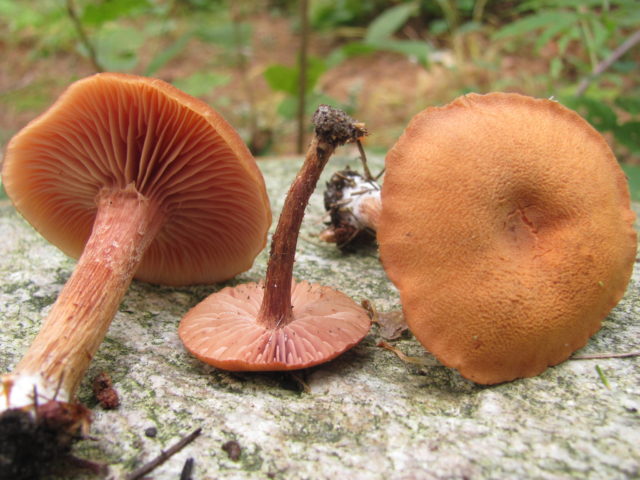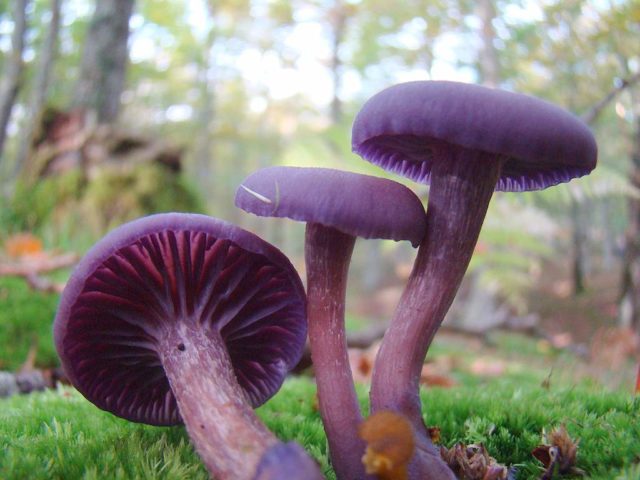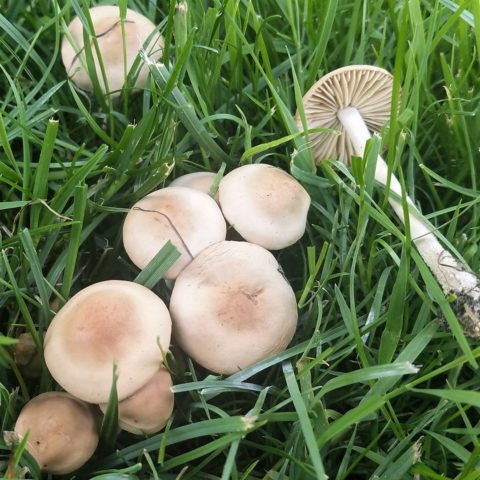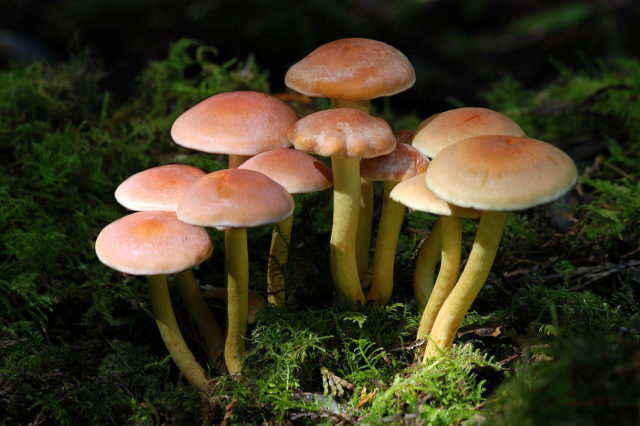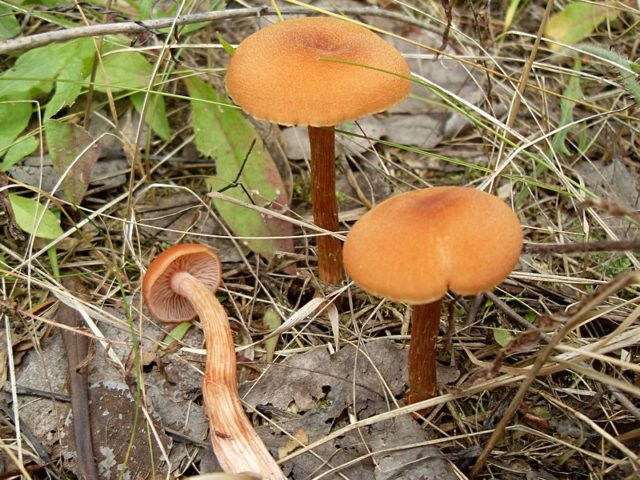Content
Common lacquer (Laccaria laccata) belongs to the Ryadovkov family. Its other names are: pink varnish, varnish varnish. The mushroom was first described by the Italian Skopoli in the 18th century. He was nicknamed "the changeling", since individual specimens differ significantly depending on the growing conditions.
What ordinary varnishes look like
Mushrooms take on a very bizarre shape. They are umbrella-shaped, with a rounded top, unfolded, depressed. Overgrown common varnishes bend the edges of the caps upward, forming a funnel. The edges of the dome are uneven, with cracks, and the surface itself is rough. They grow from 3 to 7 cm. The stem is fibrous, tubular, up to 14 cm long. At the base there is a white bloom-edge, the color is slightly darker.
The color of the cap is capable of changing from environmental conditions, which makes identification difficult. Usually it is pink and red-red, almost carrot. A dry period means a change in the color of the cap from pink to pale sandy, and with prolonged rains, the cap and leg darken to light brown. The plates are dense, fleshy on the inside. Their color is fully consistent with the top.
Where do common varnishes grow
It grows everywhere in the Northern Hemisphere, excluding permafrost zones. Appears in mid-June and grows until frost, in groups or singly. Often appears in areas of new plantations and areas contaminated by felling, where other species do not survive.
Loves mixed deciduous-coniferous forests. Very picky about the neighborhood with a tree and does not tolerate competition. Often found in the vicinity of shrubs. Does not like swampy and dry soil. Her pink caps peep out of the grass in forest meadows, on forest edges, and in old parks. But there it can be dry on the vine.
Is it possible to eat common varnishes
Pink lacquer belongs to edible specimens. Due to its low nutritional value, it is not very popular among mushroom pickers. However, there are seasons when it is she who gives a bountiful harvest.
Taste qualities of the mushroom common varnish
The culinary value is not high; hats are used more often. The pulp is light, brittle, with a barely expressed aroma. It tastes very delicate and is great for second courses. Most often, pink varnish is fried in combination with vegetables, herbs and spices.
False doubles
It is difficult to confuse pink lacquer with poisonous mushrooms; its counterparts are edible with rare exceptions.
- Amethyst varnish.
Edible. It is very similar in structure to ordinary varnish, and differs only in a rich purple color.
- Honey mushroom.
Edible. It differs from varnish in a pink even cap with small fluffy specks and light plates. Honey mushrooms have a characteristic smell, and the color of the leg is light, almost creamy.
- False Honey.
Poisonous. The color of its cap is difficult to distinguish from the pink varnish in dry season. But the yellow leg of the false mushroom betrays it.
Collection rules
Lacobica vulgaris usually grows in groups, from a few specimens to a few square meters of plains filled with a continuous carpet. Collect healthy mushrooms, not moldy, not dry. Too overgrown bodies should not be taken either.
Cut gently with a knife at the base without leaving a large hemp. Sometimes it is advised to twist it out of the mycelium, taking out the whole body as a whole. If in the future only hats will be processed, the legs can be gently broken off and left in the forest.
Use
Before using for cooking, ordinary varnish must be soaked in cold water for an hour. Then rinse.
Pre-boiling
Since the sizes are small, pink varnishes can be prepared whole or by cutting the caps into halves.
Required Ingredients:
- water - 2 l;
- mushrooms - 0.7 kg;
- salt - 5 g.
Recipe:
- Dip the mushrooms in water and bring to a boil.
- Cook for 10-20 minutes.
- Strain through a colander.
The product is ready for further processing.
Frying
The taste of roasted rose lacquer is very similar to a pearl raincoat.
Required Ingredients:
- pink varnishes - 1 kg;
- salt - 5 g;
- onions - 2 pcs.;
- greens, peppers to taste;
- vegetable oil - 2 tbsp. l.
Recipe:
- Pour oil into a preheated pan, put onion chopped into rings or strips.
- Fry the onion until golden brown, lay out the boiled mushrooms in an even layer.
- Season with salt, pepper, fry for 20 minutes.
- Sprinkle with herbs 5 minutes before being ready.
If desired, this recipe can be diversified: add sour cream sauce, tomato, potatoes or eggplant.
Salting
Can be salted or pickled. Although, due to their fragile structure, they will not turn out to be very tasty.
Required Ingredients:
- boiled varnishes - 3 kg;
- salt - 120 g;
- sugar - 15 g;
- fresh horseradish root - 80 g;
- horseradish leaf - 6 pcs.;
- garlic - 1 pc.;
- dill - 3 stems with umbrellas;
- peppercorns - 15 pcs.;
- bay leaf - 6 pcs.
Recipe:
- In an enamel, glass or clean wooden container, lay out successively in layers: a layer of herbs, a layer of mushrooms, sprinkle with chopped onions and garlic, salt and sugar, repeat until you run out of products. Finish off with a layer of greenery.
- Put on top a clean plate or an enameled upside-down lid, put a load on top - a jar of water or a bottle.
- As soon as the juice appears, you can eat. This usually takes 2-4 days.
It can also be dried to obtain a nutritional powder and frozen after pre-boiling or frying.
Conclusion
Lacovita vulgaris is widespread in the northern latitudes of Russia and Europe. She is the very first to appear in meadows and forests, she can be harvested until the end of autumn, until frost comes. Edible, can be used to prepare various culinary dishes, as a dry powder-seasoning. It is difficult to confuse it with other species, it has no poisonous counterparts. However, care and caution should be exercised when collecting.
